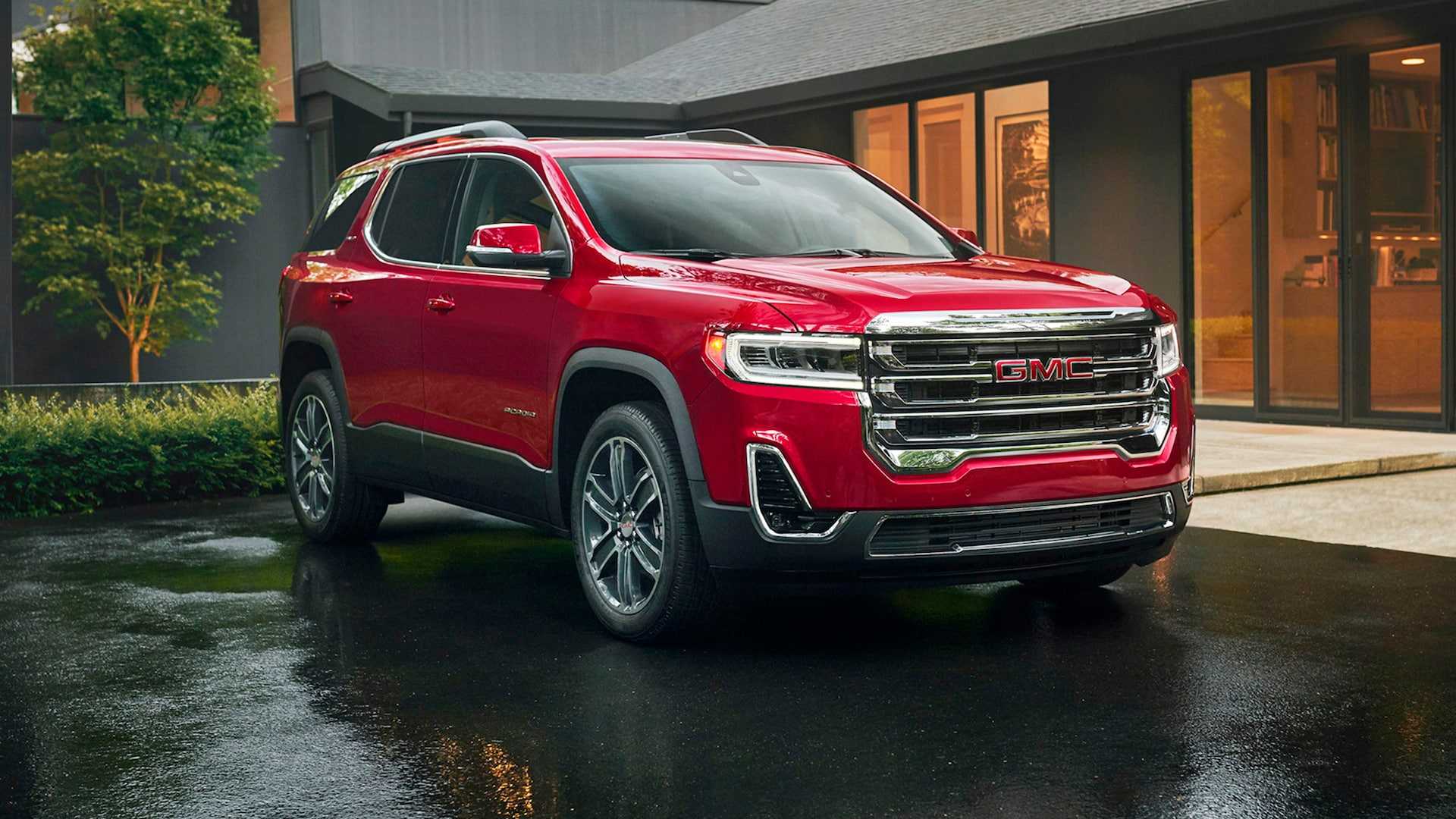GMC Acadia 2023 Engine Exhaust and Brakes
The Engine, Exhaust, and Brakes systems of the 2023 GMC Acadia are all designed to make driving it strong and effective. Under the hood, the Acadia usually comes with a variety of powerful engine choices, such as gasoline and hybrid powertrains that are made to work well and use little fuel. The exhaust system controls emissions well and improves the general performance of the vehicle. The brakes are also carefully tuned to provide responsive stopping power. Safety and control are improved by features such as anti-lock brakes (ABS) and electronic brake-force distribution (EBD). The Acadia’s engine, exhaust, and brakes all work together to make driving confident and enjoyable, whether you’re speeding up on the highway, handling city streets, or stopping.
2023 GMC ACADIA Specs, Price, Features and Mileage (Brochure)
Engine Exhaust
Warning
Engine exhaust contains carbon monoxide (CO), which cannot be seen or smelled. Exposure to CO can cause unconsciousness and even death.
Exhaust may enter the vehicle if:
- The vehicle idles in areas with poor ventilation (parking garages, tunnels, deep snow that may block underbody airflow or tail pipes).
- The exhaust smells or sounds strange or different.
- The exhaust system leaks due to corrosion or damage.
- The vehicle exhaust system has been modified, damaged, or improperly repaired.
- There are holes or openings in the vehicle body from damage or aftermarket modifications that are not completely sealed.
If unusual fumes are detected or if it is suspected that exhaust is coming into the vehicle:
- Drive it only with the windows completely down.
- Has the vehicle been repaired immediately?
Never park the vehicle with the engine running in an enclosed area such as a garage or a building that has no fresh air ventilation.
Running the Vehicle While Parked
It is better not to park with the engine running. If the vehicle is left with the engine running, follow the proper steps to be sure the vehicle will not move. If parking on a hill and pulling a trailer,
Automatic Transmission
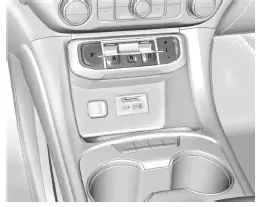
The shift switches are on the center stack. The selected gear position will illuminate red on the shift switch, while all others will be displayed in white. If the shift is not immediate, as in very cold conditions, the indicator on the shift switch may flash until it is fully engaged. The transmission does not operate when the vehicle is off. If the vehicle is in accessory mode, the transmission can be shifted into P (Park). If ENGINE START/STOP is pressed twice while at a relatively high speed, the engine will turn off and the transmission will automatically shift to N (Neutral). Once the vehicle is stopped, P (Park) can be selected. P: This position locks the drive wheels. Use P (Park) when starting the vehicle to ensure the vehicle does not move.
Warning
when on fairly level ground, always set the parking brake and place the transmission into P (Park). This vehicle is equipped with an electronically controlled transmission. The R (Reverse) and D (Drive) shift switches are designed to prevent inadvertent shifting out of P (Park) unless the ignition is on, and the brake pedal is applied. When the vehicle is stopped, press ENGINE START/STOP to turn off the vehicle. The transmission will shift to P (Park) automatically. The vehicle will not shift into P (Park) if it is moving too fast. Stop the vehicle and shift into P (Park). To shift in and out of P (Park),
R: Use this gear to back up. If the vehicle is shifted from either R (Reverse) to D (Drive), or D (Drive) to R (Reverse) while the speed is too high, the vehicle will shift to N (Neutral). Reduce the vehicle speed and try the shift again.
To shift into R (Reverse):
- Bring the vehicle to a complete
- Pull the R (Reverse) switch on the center
To shift out of R (Reverse):
- Bring the vehicle to a complete
- Shift to the desired
At low vehicle speeds, R (Reverse) can be used to rock the vehicle back and forth to get out of snow, ice, or sand without damaging the transmission.
N: In this position, the engine does not connect with the wheels. To restart the engine when the vehicle is already moving, use N (Neutral) only.
Warning
Shifting into a drive gear while the engine is running at high speed is dangerous. Unless your foot is firmly on the brake pedal, the vehicle could move very rapidly. You could lose control and hit people or objects. Do not shift into a drive gear while the engine is running at high speed. the brake pedal, the vehicle could move very rapidly. You could lose control and hit people or objects. Do not shift into a drive gear while the engine is running at high speed.
Caution
Shifting out of P (Park) or N (Neutral) with the engine running at high speed may damage the transmission. The repairs would not be covered by the vehicle warranty. Be sure the engine is not running at high speed when shifting the vehicle.
Caution
The vehicle is not designed to stay in N (Neutral) for extended periods of time. It will automatically shift into P (Park). To shift into N (Neutral), press the N (Neutral) switch until the N indicator displays.
To shift out of N (Neutral):
- Bring the vehicle to a complete
- Shift to the desired
Car Wash Mode
This vehicle includes a Car Wash Mode that allows the vehicle to remain in N (Neutral) for use in automatic car washes. Car Wash Mode is not to be used for vehicle towing. If the vehicle needs to be towed,
Caution
The vehicle is not designed to stay in N (Neutral) for extended periods of time. It will automatically shift into P (Park) if left in Car Wash Mode.
Car Wash Mode (Engine Off – Driver in Vehicle)
To place the vehicle in N (Neutral) with the engine off and the vehicle occupied:
- Drive to the entrance of the car
- Apply the brake
- Shift to N (Neutral).
- Turn off the engine and release the brake pedal.
- The indicator should continue to show If it does not, start the engine and repeat Steps 2–4.
- The vehicle is now ready for the car wash.
Car Wash Mode (Engine Off – Driver out of Vehicle)
To place the vehicle in N (Neutral) with the engine off and the vehicle unoccupied:
- Drive to the entrance of the car
- Apply the brake
- Open the
- Shift to N (Neutral).
- Turn off the engine and release the brake pedal.
- The indicator should continue to show If it does not, start the engine and repeat Steps 2–5.
- Exit the vehicle and close The vehicle is now ready for the car wash.
- The vehicle may automatically shift to P (Park) upon re-entry.
Car Wash Mode (Engine On – Driver in Vehicle)
- Drive to the entrance of the car
- Apply the brake
- Shift to N (Neutral).
- Release the brake pedal. The vehicle is now ready for the car wash.
Car Wash Mode (Engine On – Driver out of Vehicle)
- Drive to the entrance of the car
- Apply the brake
- Open the
- Shift to N (Neutral), then release the brake pedal.
- The indicator should continue to show N. If it does not, repeat Steps 2–
- Exit the vehicle and close The vehicle is now ready for the car wash.
- The vehicle may automatically shift to P (Park) upon re-entry.
Caution
A transmission hot message may display if the automatic transmission fluid is too hot. Driving under this condition can damage the vehicle. Stop and idle the engine to cool the automatic transmission fluid. This message clears when the transmission fluid has cooled sufficiently. damage the vehicle. Stop and idle the engine to cool the automatic transmission fluid. This message clears when the transmission fluid has cooled sufficiently.
Caution
Spinning the tires or holding the vehicle in one place on a hill using only the accelerator pedal may damage the transmission. The repair will not be covered by the vehicle warranty. If the vehicle is stuck, do not spin the tires. When stopping on a hill, use the brakes to hold the vehicle in place. If equipped with the 2.0L L4 engine, engine speeds may be increased while driving at highway speeds while the engine is still warming up. L: This position gives you access to gear ranges. This provides more engine braking but lower fuel economy than D (Drive). You can use it on very steep hills, or in deep snow or mud.
Manual Mode
Electronic Range Select (ERS) Mode
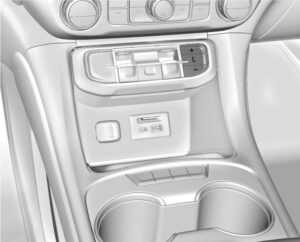
ERS or manual mode allows for the selection of the range of gear positions. Use this mode when driving downhill or towing a trailer to limit the top gear and vehicle speed. The shift position indicator within the Driver Information Center (DIC) will display a number next to the L indicating the highest available gear under manual mode and the driving conditions when the manual mode was selected.
To use this feature:
- With the vehicle in D (Drive), press the L (Low) button.
- Press the plus or minus button on the center stack to increase or decrease the gear range available. When shifting to L (Low), the transmission will shift to a preset lower gear range. For this preset range, the highest gear available is displayed next to the L in the DIC.
- (Uplevel) 0 119. All gears below that number are available to use. For example, when 4 (Fourth) is shown next to the L, 1 (First) through 4 (Fourth) gears are shifted automatically. To shift to 5 (Fifth) gear, press the + (Plus) button or shift into D (Drive).
- L (Low) will prevent shifting to a lower gear range if the engine speed is too high.
If the vehicle speed is not reduced within the time allowed, the lower gear range shift will not be completed. Slow the vehicle, then press the − (Minus) button to the desired lower gear range. While using ERS, cruise control can be used.
Drive Systems
All-Wheel Drive
Vehicles with this feature can operate in AWD Mode. Vehicles with this feature can operate in All-Wheel Drive (AWD) Mode
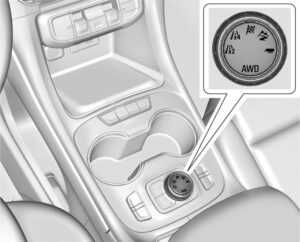
Turn the knob to4to select AWD. When operated in two-wheel drive, the vehicle will deliver power to the front wheels only and may provide better fuel economy. When using a compact spare tire on an AWD vehicle, the system automatically detects the compact spare and reduces AWD performance to protect the system. To restore full AWD operation and prevent excessive wear on the system, replace the compact spare with a full-size tire as soon as possible.
Brakes
Electric Brake Boost
Vehicles equipped with electric brake boost have hydraulic brake circuits that are electronically controlled when the brake pedal is applied during normal operation. The system performs routine tests and turns off within a few minutes after the vehicle is turned off. Noise may be heard during this time. If the brake pedal is pressed during the tests or when the electric brake boost system is off, a noticeable change in pedal force and travel may be felt. This is normal.
Antilock Brake System (ABS)
The Antilock Brake System (ABS) helps prevent a braking skid and maintain steering while braking hard. ABS performs a system check when the vehicle is first driven. A momentary motor or clicking noise may be heard while this test is going on, and the brake pedal may move slightly. This is normal. If there is a problem with ABS, this warning light stays on. ABS does not change the time needed to get a foot on the brake pedal and does not always decrease the stopping distance. If you get too close to the vehicle ahead, there will not be enough time to apply the brakes if that vehicle suddenly slows or stops. Always leave enough room ahead to stop, even with ABS.
Using ABS
Do not pump the brakes. Just hold the brake pedal down firmly. Hearing or feeling ABS operate is normal.

Braking in Emergencies
ABS allows steering and braking at the same time. In many emergencies, steering can help even more than braking.
Electric Parking Brake
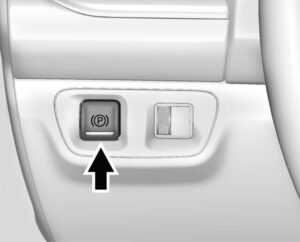
The Electric Parking Brake (EPB) can always be applied, even if the vehicle is off. In case of insufficient electrical power, the EPB cannot be applied or released. To prevent draining the battery, avoid unnecessarily repeated cycles of the EPB. The system has a red parking brake status light and an amber service parking brake warning light. There are also parking brake-related Driver Information Center (DIC) messages. Before leaving the vehicle, check the red parking brake status light to ensure that the parking brake is applied.
EPB Apply
To apply the EPB:
- Be sure the vehicle is at a complete
- Press the EPB switch
The red parking brake status light will flash and then stay on once the EPB is fully applied. If the red parking brake status light flashes continuously, then the EPB is only partially applied or there is a problem with the EPB. A DIC message will display. Release the EPB and try to apply it again. If the light does not come on or keeps flashing, have the vehicle serviced. Do not drive the vehicle if the red parking brake status light is flashing. See your dealer. If the amber service parking brake warning light is on, press the EPB switch. Continue to hold the switch until the red parking brake. status light remains on. If the amber service parking brake warning light is on, see your dealer. If the EPB is applied while the vehicle is moving, the vehicle will decelerate as long as the switch is pressed. If the switch is pressed until the vehicle comes to a stop, the EPB will remain applied. The vehicle may automatically apply the EPB in some situations when the vehicle is not moving. This is normal and is done to periodically check the correct operation of the EPB system, or at the request of other safety functions that utilize the EPB. If the EPB fails to apply, block the rear wheels to prevent vehicle movement.
EPB Release
- Turn the ignition on or to ACC
- Apply and hold the brake
- Press the EPB switch
The EPB is released when the red parking brake status light is off. If the amber service parking brake warning light is on, release the EPB by pressing and holding the EPB switch. Continue to hold the switch until the red parking brake status light is off. If either light stays on after release is attempted, see your dealer.
Caution
Driving with the parking brake on can overheat the brake system and cause premature wear or damage to brake system parts. Make sure that the parking brake is fully released and the brake warning light is off before driving. If you are towing a trailer and parking on a hill.
Automatic EPB Release
The EPB will automatically release if the vehicle is running, placed into gear, and an attempt is made to drive away. Avoid rapid acceleration when the EPB is applied, to preserve parking brake lining life.
Brake Assist
Brake Assist detects rapid brake pedal applications due to emergency braking situations and provides additional braking to activate the Antilock Brake System (ABS) if the brake pedal is not pushed hard enough to activate ABS normally. Minor noise, brake pedal pulsation, and/or pedal movement during this time may occur. Continue to apply the brake pedal as the driving situation dictates. Brake Assist disengages when the brake pedal is released.
Hill Start Assist (HSA)
Do not rely on the HSA feature. HSA does not replace the need to pay attention and drive safely. You may not hear or feel alerts or warnings provided by this system. Failure to use proper care when driving may result in injury, death, or vehicle damage. When the vehicle is stopped on a grade, Hill Start Assist (HSA) prevents the vehicle from rolling in an unintended direction during the transition from brake pedal release to accelerator pedal apply. The brakes release when the accelerator pedal is applied. If the accelerator pedal is not applied within a few minutes, the Electric Parking Brake will apply. The brakes may also release under other conditions. Do not rely on HSA to hold the vehicle. HSA is available when the vehicle is facing uphill in a forward gear, or when facing downhill in R (Reverse). The vehicle must come to a complete stop on a grade for HSA to activate.
FAQ
The Acadia often offers various engine options, including gasoline and hybrid powertrains, providing a range of performance and efficiency choices.
To check the engine oil level, consult the owner’s manual for instructions on locating and using the dipstick.
Yes, the owner’s manual typically includes a maintenance schedule that outlines recommended intervals for engine oil changes.
The exhaust system efficiently manages and channels exhaust gases away from the engine while reducing emissions to meet environmental standards.
Some aftermarket exhaust options may be available for those looking to modify the exhaust system, but it’s essential to ensure compliance with local regulations.
The Acadia may feature an EGR system to reduce nitrogen oxide emissions and improve fuel efficiency.
Periodic inspections of the exhaust system are recommended, especially if you notice unusual noises or odors. Consult the owner’s manual for guidelines.
The vehicle’s onboard diagnostics system may trigger a warning light if there’s an issue with the exhaust system.
The Acadia typically features a hydraulic brake system with disc brakes on all four wheels.
Yes, the Acadia often comes equipped with ABS, which helps prevent wheel lockup during hard braking.
EBD is a feature that optimizes brake force to each wheel to maximize braking efficiency and stability, especially when the vehicle is loaded. It’s typically integrated into the brake system.
Brake inspections and maintenance are essential. Refer to the owner’s manual for recommended service intervals.
Towing capabilities and brake considerations depend on the specific Acadia model and trim level. Consult the owner’s manual for towing guidelines and requirements.
Brake fluid is crucial for transmitting hydraulic pressure from the brake pedal to the brake calipers, enabling the vehicle to stop.
Some performance-oriented brake upgrade options may be available for certain Acadia models, but they should be installed by professionals to ensure safety.
Useful Link
View Full User Guide: GMC Acadia 2023 User Guide
Download Manuals: https://www.cadillac.com/support/vehicle/manuals-guides
2023 GMC ACADIA Specs, Price, Features and Mileage (Brochure)

